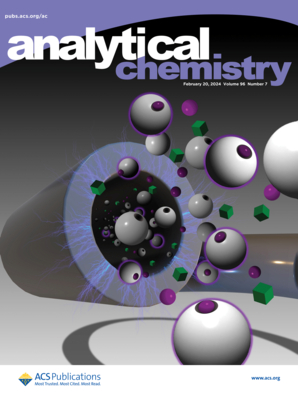Single-Use Electrochemical Aptamer-Based Sensors for Calibration-Free Measurements in Human Saliva via Dual-Frequency Approaches: Prospects and Challenges
IF 6.7
1区 化学
Q1 CHEMISTRY, ANALYTICAL
引用次数: 0
Abstract
Despite the rapid growth in aptamer-based biosensor research, there remains a significant demand for aptasensors that operate without the need for sample preparation and calibration, to better facilitate real-world applications. Electrochemical aptamer-based (EAB) sensors, particularly those utilizing a dual-frequency, calibration-free approach, have shown promising advances toward commercialization. Single-use, disposable sensors represent a cost-effective solution for at-home and on-site point-of-care (POC) diagnostics. However, the development of these sensors presents unique challenges compared to in vivo monitoring and reusable platforms, with pronounced variations across sensors and batches. Motivated by these challenges, we have comprehensively investigated the dual-frequency, calibration-free approach, focusing on sensor-to-sensor and batch-to-batch variations. Our research explored the use of a nonresponsive frequency-based ratiometric method for detecting cocaine with laser-ablated, disposable EAB sensors. Additionally, to overcome the absence of nonresponsive frequencies in some aptasensors, we developed strategies to modify the aptamer structure and optimize operational conditions, effectively tailoring nonresponsive frequencies to allow for rapid result turnover. Moreover, we assessed the effects of various filter types on saliva pretreatment using liquid chromatography with tandem mass spectrometry (LCMS/MS) and developed a saliva collection workflow using an oral swab. This workflow and the disposable aptasensors developed herein achieved low μM sensitivity in saliva, with results obtainable in under 5 min, including saliva collection and processing. Furthermore, our findings indicate that certain food and drink residues in saliva can compromise sensor accuracy, highlighting an area for future refinement.

求助全文
约1分钟内获得全文
求助全文
来源期刊

Analytical Chemistry
化学-分析化学
CiteScore
12.10
自引率
12.20%
发文量
1949
审稿时长
1.4 months
期刊介绍:
Analytical Chemistry, a peer-reviewed research journal, focuses on disseminating new and original knowledge across all branches of analytical chemistry. Fundamental articles may explore general principles of chemical measurement science and need not directly address existing or potential analytical methodology. They can be entirely theoretical or report experimental results. Contributions may cover various phases of analytical operations, including sampling, bioanalysis, electrochemistry, mass spectrometry, microscale and nanoscale systems, environmental analysis, separations, spectroscopy, chemical reactions and selectivity, instrumentation, imaging, surface analysis, and data processing. Papers discussing known analytical methods should present a significant, original application of the method, a notable improvement, or results on an important analyte.
 求助内容:
求助内容: 应助结果提醒方式:
应助结果提醒方式:


